 Research Article
Research Article
Design and Develop a Telephony System for Establishing Calls between Two PBX Servers Using IAX2 Protocol
Biswas Kumar1*, Md. Asadujjaman Nur2 and Debashis Kumar Dey2
1Department of Computer science and Engineering, European University of Bangladesh, Gabtoli, Dhaka-1216, Bangladesh
2Institute of Information Technology (IIT), Jahangirnagar University, Savar, Dhaka-1342, Bangladesh
Biswas Kumar, Department of Computer science and Engineering, European University of Bangladesh, Gabtoli, Dhaka-1216, Bangladesh.
Received Date:January 30, 2023; Published Date:February 10, 2023
Abstract
Telephony system is the most common way for modern communication. People can communicate with each other’s through various ways. Most common existing telephony system are PSTN, ISDN which have lot of drawback such as consume more bandwidth, unreliability, insecure communication media, complex to maintenance. The project design and develop a Telephony system for transferring voice calls within a wired or wireless network. This system works within home, office, simple organization, a campus area to communicate with each other within a wired or wireless zone. In this system communication can takes place between users to users. This project integrates voice with data network and transfer voice over data network more efficiently. There are many existing protocols for transferring voice over data network but none of these are fully perfect. So, the task uses such protocol which satisfies maximum criteria of all existing protocols. For configuring trunk and channels between two servers IAX2 is used. Developed System able to transfer calls from one terminal device to another terminal device within the same or different PBX which consume less bandwidth and quality of calls are better than any other protocols.
Introduction to the Industry of Electricity in the Sudan
Telephony system is the most important part of communication. In Modern communication circuit-switched network is common way for person to person communication which is referred to as Public Switched Telephone Networks (PSTN). But communication cost is high, unreliable, maintenance is complex, call routing is complex in circuit-switched network. To reduce these problems, a new trend that is beginning to emerge in recent years is to provide telephony service over IP networks, known as IP telephony. Advantage of this network is cost savings, especially for corporations with large data networks. This system is easy to configure, easy to implement within campus, in a business office and other sectors with no cost. The main advantages of IP telephony is easily integrate with existing system like PSTN, GSM network. These systems are not only transfer calls but also send email, chat with others, establish video calls etc. In telephony system server to server communication or server to user communication there are different types trunking protocol such SIP, IAX2, RDP, H.323 etc. In this project IAX2 protocol is used.
The objective of this project is to design and develop a telephony
system within a local LAN or Wireless network. This system
maintains communication within an organization through telephony
system which reduces communication cost dramatically. It provides
communication within a local network.
• Develop a telephony system within a LAN or wireless network
• Configuration of two PBX server
• Connecting two PBX using IAX2 trunking protocol
• Maintaining communication of an organization within
LAN or wireless network
• Reduce communication cost within an organization
• Users can use both soft phone and telephone
System Review
There are different trunking protocols such as H.323, SIP, and SDP etc. Comparing SIP with protocols we can say that SIP protocols best of them, but it has some limitation. Few years ago, IAX protocol is invented and then it is one of the best over SIP. Different types of Telecommunication Company such as Sussex [1], NetTelco [2] use IAX2 protocol for their communication.
Bandwidth consumption comparison of SIP and IAX [3,4] (Table 1)
Table 1:BW of some protocols with codec.

From Table 1 it is seen that
a. SIP & G.711 codec produce very good quality of voice, but
it consumes highest bandwidth.
b. IAX & GSM codec consume lowest bandwidth, but it produced
high traffic.
c. IAX & G.711 codec requires high bandwidth and ideal for
power traffic level is relatively high.
d. SIP & GSM codec is ideal for plans that do not support IAX.
Analyzing the table data, we can say that IAX protocol is good call transferring.
So IAX2 is used and develop this system with the following
stepsi.
Environment Setup
ii. Connecting Asterisk PBX [5] server with IAX2 trunking
protocol and establish call session in real-time network.
iii. Check the system and protocol with others for development.
Methodology
First of all, we need to setup open source Linux Operating then
install Asterisk PBX, Free PBX web GUI on it. Calculate IP for PBX
and terminal devices.
• Configuring IAX2 Trunks
• Configuring the Outbound Routes
• Create channels for end users and bind them with PBX
• Test Call generate and service testing
System Model
In this system Asterisk PBX, Different types of terminal devices, IAX2 tunneling protocol are used (Figure 1).
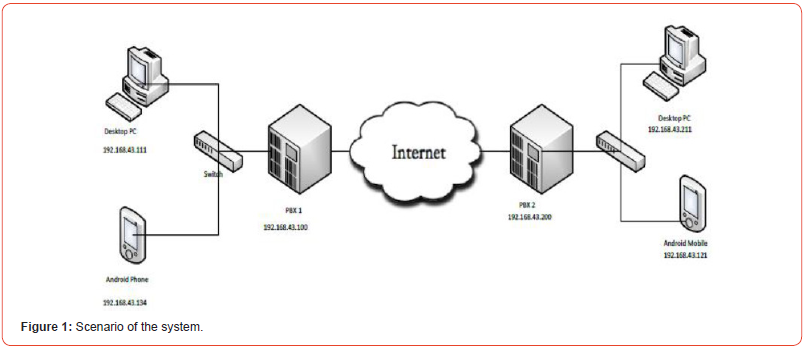
Asterisk architecture
Asterisk consists of five base components [6]:
• Dynamic Module Loader - When Asterisk was first started,
the Dynamic Module Loader loads and initializes each of the
drivers which provide channel drivers, file formats, call detail
record backends, codecs, applications and more, linking them
with the appropriate internal APIs.
• PBX Switching - The essence of Asterisk is a Private
Branch Exchange Switching system, connecting calls together
between various users and automated tasks. The Switching
Core transparently connects callers arriving on various hardware
and software interfaces.
• Application Launcher - launches applications which perform
services for users, such as voicemail, file playback, and directory
listing (Figure 2).
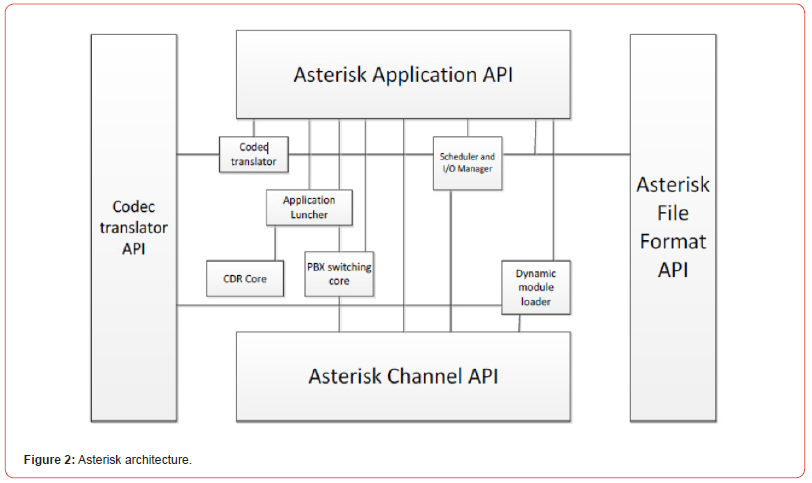
• Codec Translator - uses codec modules for the encoding
and decoding of various audio compression formats used in the
telephony industry. A number of codecs are available to suit diverse
needs and arrive at the best balance between audio quality
and bandwidth usage.
• Scheduler and I/O Manager - handles low-level task
scheduling and system management for optimal performance
under all load conditions.
There are many types of trunking protocols. Among them we differentiate SIP and IAX2 [7] (Table 2)
Table 2:Difference between IAX2 and SIP.

Implementation Step 1:
For setup Asterisk we need to run Linux Server and Centos is such kind of server. So, first setup centos 6.4 server from DVD or ISO (Figure 3).
Step 2:
After completing the installation, the login screen appears that means CentOS setup is finished. Now it is ready to provide root and centos as login username and password. Then it appears terminal and writes the command for installing Asterisk and FreePBX GUI [7-9]. After install Asterisk and Free PBX GUI, it is ready to use (Figure 4).
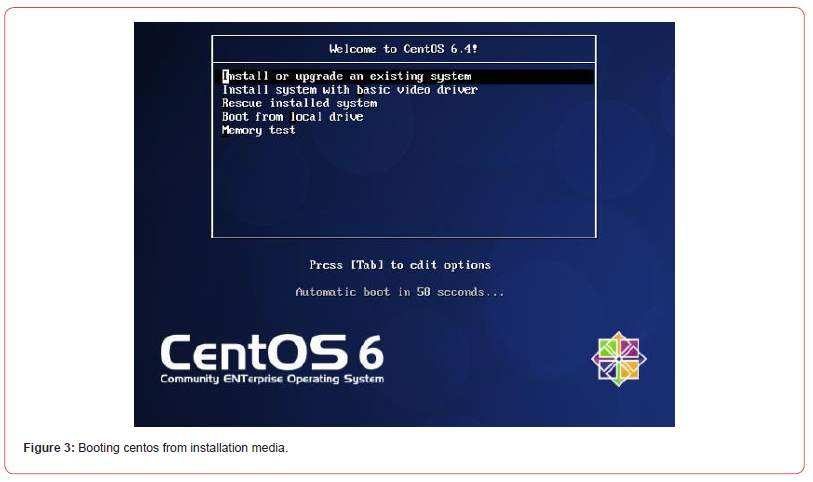
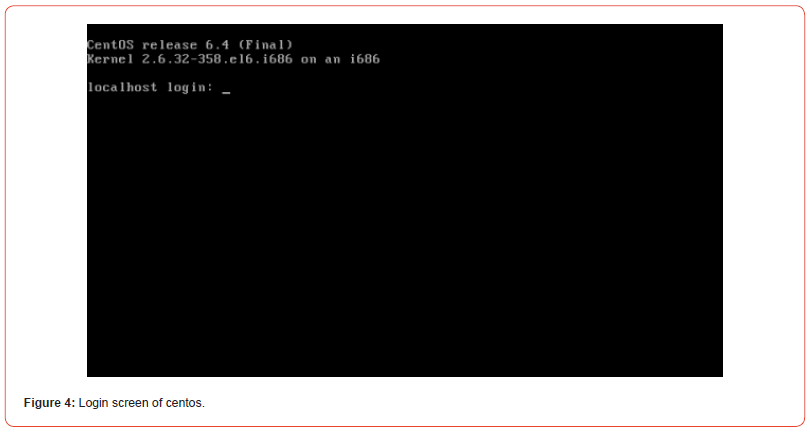
Step 3:
Normally server has default configuration with DHCP, and dynamic
addresses are change frequently. So, it needs to change with
static IP. For implementation IP with network 192.168.43.0 and
subnet mask 255.255.255.0 is used.
IP addresses of each device (Table 3)
Table 3:Assigning IP address.

Step 4:
For configuring PBX first, it is needed to access the server. This can be described in two ways. One is by SSL by terminal of another PC and another is by accessing the GUI which is previously installed into it. This GUI runs on web server reside on it. For graphically access first find the IP address and put it on the remote browser in the same network. Then we access the Graphical login page (Figure 5).
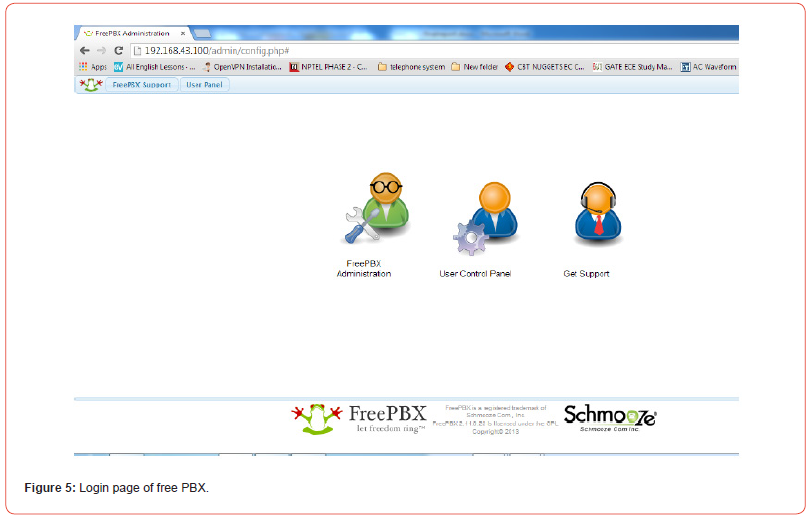
Step 5:
Accessing the GUI from browser it asks username and password. After inserting the username and password “FreePBX System Status” page will appear. We start our main configuration from here (Figure 6) [10].
Step 6:
For integrate terminal device need to channel which transfer calls between end device and PBX. So, configure the extension file with user number and password including channel protocol (Figure 7).
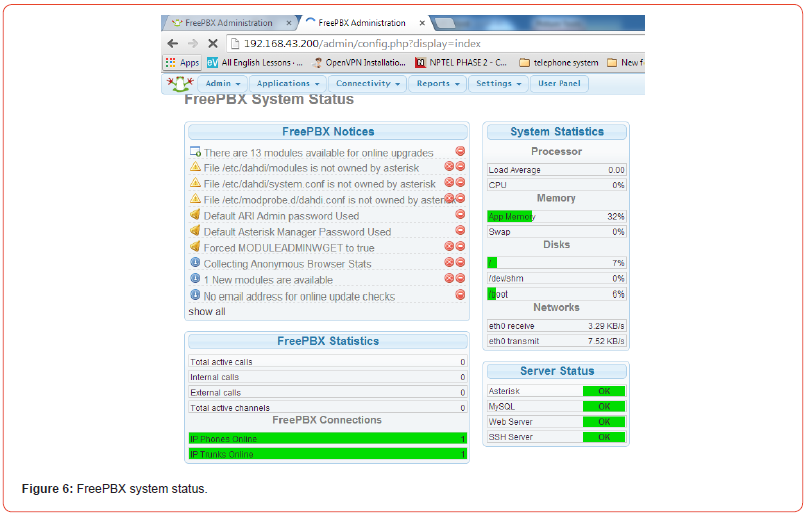
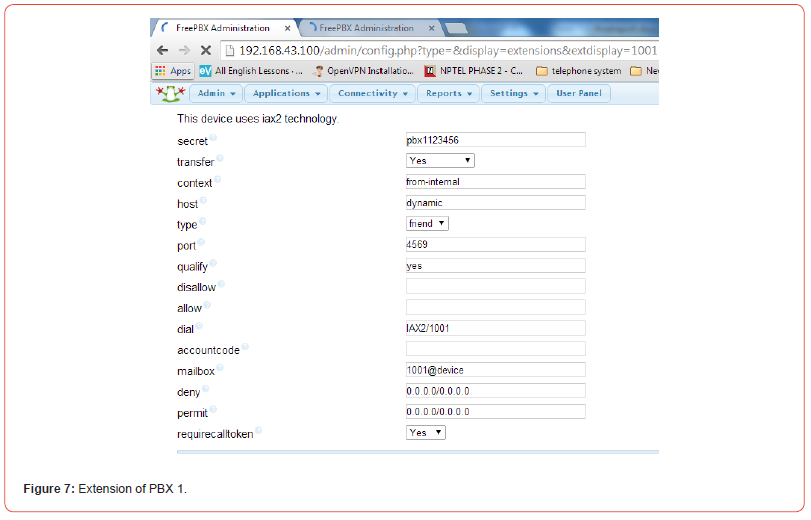
Step 7:
For transfer call from one server to another server it is necessary to configure trunk with appropriate transfer rule. If the dialed number matches with the dial manipulation rule the trunk transfer the call, otherwise not (Figure 8).
Step 8:
Need to configure handset for connecting to PBX 1. For this it is necessary to provide account name, host, username, password etc. After providing the correct information click save button and it automatically connects the PBX server (Figure 9).

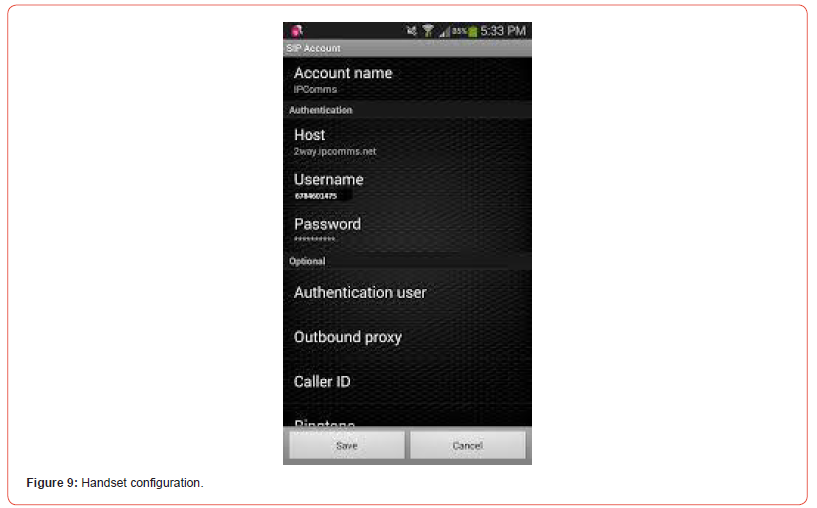
Conclusion
Implementing the protocols, the project found that IAX2 is better than SIP for trunking between two PBX servers. Comparisons are shown in Table 3 between IAX2 and SIP [11]. This system serves better than the system which is configured by SIP protocol used in various existing system. If the server resides different network, it fails to communicate [12].
Future Work
• We design and develop a new trunking protocol which reduces
more bandwidth.
• Develop a pre-configured bootable OS which automatic
connect to the radius server using MAC address verification.
• Implementation of MAC addresses authentication and
verification.
Acknowledgement
None.
Conflict of Interest
No conflict of interest..
References
- Sussex Telecommunications (2002) sussex grounp.
- NWI Ltd (2003) NET-TELCO.
- David Merel, David Gomillion, Barrie Dempster (2009) Asterisk 1.6 Build feature-rich telephony systems with Asterisk. Olton, UK : Packt Publishing Ltd. 978-1-847198-624.
- Blanchard, Eugene (2014) Voice Over IP(VoIP). telecomworld.
- Wadhwa, Priyesh (2007) Design of PSTN-VoIP Gateway with inbuilt PBX & SIP extensions for Wireless medium. Bomby, India.
- Claudio Sacchi, Matteo Piazza, Francesco GB (2007) De Natale. Cost-Effective VoIP Services for Reducing Digital Divide in Developing Countries: Case of Study and Practical Implementation. Trento: DEPARTMENT OF INFORMATION AND COMMUNICATION TECHNOLOGY, UNIVERSITY OF TRENTO.
- (2014) talk. Inter-Asterisk eXchange. wikipidia.
- Russell Bryant, Leif Madsen, Jim Van Meggelen (2013) Asterisk: The Definitive Guide, 4th s.l. : 1-4493-3241-2, O'Reilly Media.
- Forouzan, Behrouz A (2007) DATA COMMUNICATIONS AND NETWORKING, 4th s.l. 978-0-07-296775-3. McGraw-Hill.
- M Spencer, M Allison, C Rhodes (2003) The Asterisk Handbook. s.l. : Asterisk Documentation Team.
- Volker (2002) Voice over IP. Wikipedia, the free encyclopedia.
- Deshmukh, Devesh Mendiratta, Sameer. http://web.cs.sunyit.edu/~deshmus/Voicecom/Papers/.
-
Biswas Kumar*, Md. Asadujjaman Nur and Debashis Kumar Dey. Design and Develop a Telephony System for Establishing Calls between Two PBX Servers Using IAX2 Protocol. Glob J Eng Sci. 10(5): 2023. GJES.MS.ID.000750.
-
Telephony system, PBX server, IAX2 protocol, Trunk
-

This work is licensed under a Creative Commons Attribution-NonCommercial 4.0 International License.






